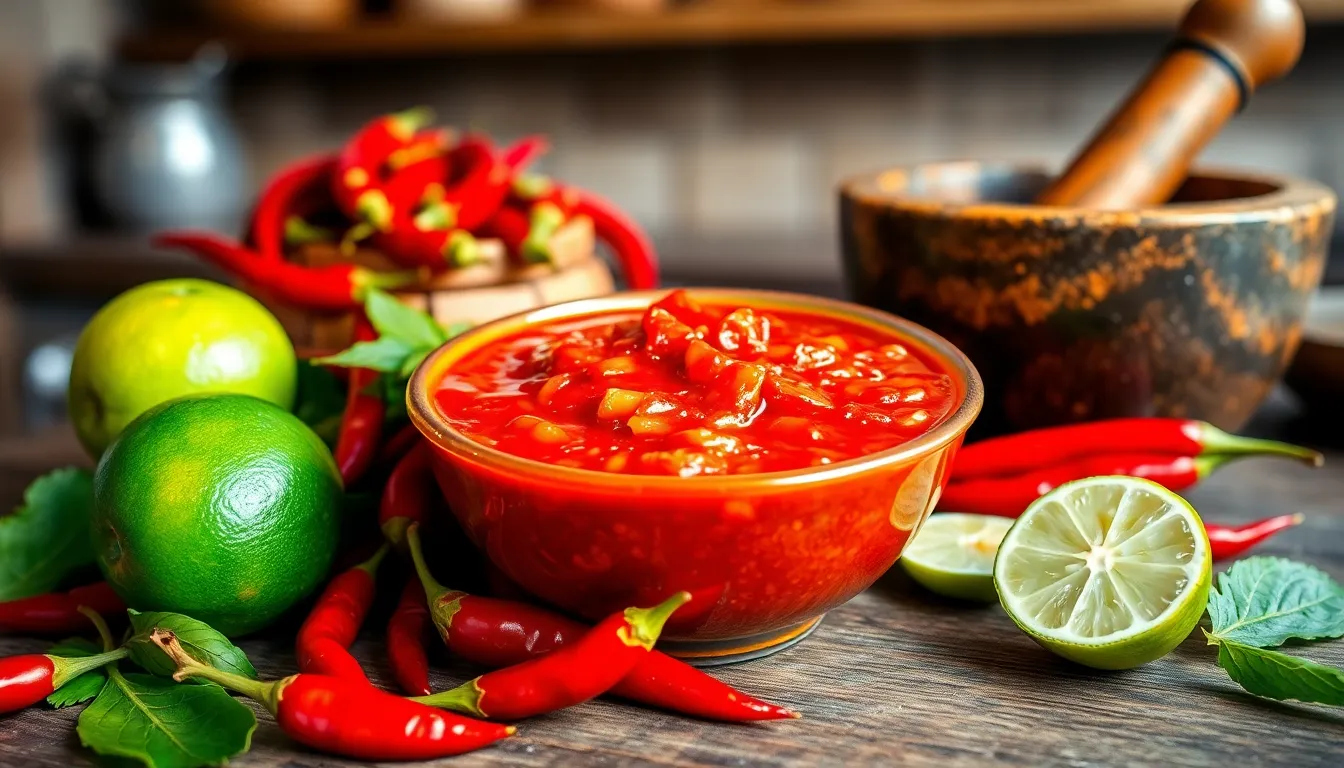Craving that authentic Indonesian heat? Sambal terasi is the fiery condiment that transforms ordinary meals into extraordinary culinary experiences. Discover why this traditional chili paste has captured taste buds across Southeast Asia.
Sambal terasi brings together the perfect balance of heat, umami and tang that’s quintessentially Indonesian. This powerful chili paste combines fresh red chilies, pungent fermented shrimp paste (terasi), lime juice, and a hint of palm sugar. It’s the secret weapon in countless Indonesian kitchens, adding depth and complexity to everything from rice dishes to grilled meats.
You’ll find this versatile condiment accompanying nearly every meal in Indonesia, where each region boasts its own variation. While the intense aroma might surprise first-timers, one taste of this complex, aromatic paste will have you understanding why Indonesians consider a meal incomplete without a dollop of sambal terasi on the side.
What is Sambal Terasi?
Sambal terasi is an iconic Indonesian chili relish that combines fiery red chilies with terasi (fermented shrimp paste) creating a complex condiment that delivers intense heat with deep umami flavors. This pungent paste serves as both a standalone condiment and a flavor foundation in countless Indonesian dishes. The fermentation process of the shrimp paste imparts a distinctive funky aroma and savory depth that transforms simple ingredients into something extraordinarily flavorful.
Unlike other sambals found throughout Indonesia sambal terasi stands out due to its inclusion of terasi which gives it a unique flavor profile unmatched by other chili-based condiments. The paste gets its characteristic reddish-brown color from the blend of fresh red chilies and the dark fermented shrimp paste. Most Indonesians consider meals incomplete without this essential condiment on the table.
Traditional preparation involves grinding fresh ingredients on a stone mortar and pestle (known as cobek and ulekan) which releases the oils and flavors more effectively than mechanical processing. The texture typically remains somewhat coarse rather than completely smooth allowing each component to retain some individual character. Regional variations exist throughout the archipelago with differences in spice levels sweetness and additional aromatics based on local preferences.
Sambal terasi pairs exceptionally well with fried foods grilled fish vegetable dishes and rice. Its powerful umami quality enhances virtually any savory food making even the simplest meal memorable. Even though its initially challenging aroma for those unfamiliar with fermented shrimp paste the complex flavor that develops is what makes this condiment addictively delicious and a must-have in Indonesian cuisine.
Why You’ll Love This Indonesian Chili Sauce

Explosive Flavor Profile
You’ll immediately notice the perfect balance between fiery heat and deep umami flavors in sambal terasi. The combination creates a multi-layered taste experience unlike any other chili sauce. Bird’s eye chilies deliver that signature spicy kick while the fermented shrimp paste provides a rich savory foundation that transforms simple dishes into memorable meals.
Versatility in Every Spoonful
Your culinary repertoire will expand dramatically with this condiment in your kitchen. Sambal terasi works beautifully as a dipping sauce for fried snacks or grilled meats. Many Indonesian home cooks use it as a flavor enhancer for stir-fries or mix it directly into steamed rice. The sauce pairs exceptionally well with vegetables making even simple preparations extraordinary.
Authentic Cultural Experience
Each spoonful connects you to centuries of Indonesian culinary tradition. This sauce represents the bold flavor philosophy central to Indonesian cooking where complex tastes are prized. Regional variations exist throughout the archipelago but the core elements remain consistent—chilies shallots garlic and that distinctive terasi that makes this sambal uniquely Indonesian.
Customizable Heat Level
Adjust the spiciness to suit your preference by controlling the number and type of chilies. Traditional recipes often use fiery bird’s eye chilies but you can substitute milder varieties for a gentler experience. The depth from shrimp paste remains consistent regardless of heat level ensuring you always get that authentic flavor profile.
Impressive Shelf Life
Your homemade batch keeps well in the refrigerator for up to two weeks allowing you to enjoy its complex flavors anytime. The cooking process helps preserve the sauce while the salt and acidity from lime juice act as natural preservatives. Many enthusiasts claim the flavor actually improves after a day or two as ingredients meld together.
Key Ingredients for Authentic Sambal Terasi

Creating genuinely authentic sambal terasi requires exact ingredients that contribute to its characteristic robust flavor profile. These carefully selected components work together to create the perfect balance of heat, umami and tang that makes this Indonesian chili sauce so beloved.
Choosing the Right Chilies
Bird’s eye chilies form the fiery backbone of sambal terasi, delivering intense heat that defines this condiment. Larger red chilies such as red-spur or serrano varieties should be included to provide milder fruity notes and the vibrant red color that makes sambal terasi visually appealing. You might also incorporate Thai chilies for additional spiciness if you prefer an extra kick in your sambal. Fresh chilies yield the best results, though some recipes recommend soaking them briefly to soften their texture or moderate the heat level before grinding. The combination of different chili varieties creates a complex heat profile that distinguishes truly authentic sambal terasi from simpler chili pastes.
About Terasi (Shrimp Paste)
Terasi stands as the defining ingredient in this sambal variation, imparting the distinctive umami depth that makes this condiment uniquely craveable. This fermented shrimp paste comes in block or powder form after being processed from ground shrimp or small fish that undergo extensive fermentation and drying. Traditional Indonesian preparations specifically call for terasi bakar (grilled shrimp paste) to develop its aromatic qualities before incorporation. Malaysian belacan or Thai kapi can serve as reasonable substitutes when authentic Indonesian terasi proves difficult to find. The preparation method matters significantly – terasi should be briefly cooked in hot oil to release its full aroma before mixing with other ingredients. This crucial step transforms the initially pungent smell into a complex savory foundation that elevates the entire sauce.
Fresh Aromatics
Shallots contribute essential sweetness and mild pungency that balances the intense heat from the chilies in sambal terasi. Garlic adds depth and aromatic complexity that rounds out the flavor profile of this versatile condiment. Many authentic recipes incorporate fresh tomatoes to introduce acidity and create a more substantial body in the finished sauce. Lime juice should be added as a final touch to bring brightness and balance to the rich, spicy mixture. Palm sugar or dark brown sugar provides crucial sweetness that harmonizes with the saltiness from the shrimp paste and counters the chilies’ heat. Salt enhances all the other flavors while helping to preserve the sambal. These fresh aromatics transform what could be a simple hot sauce into a nuanced condiment with multiple layers of flavor that complement nearly any dish in Indonesian cuisine.
Equipment Needed
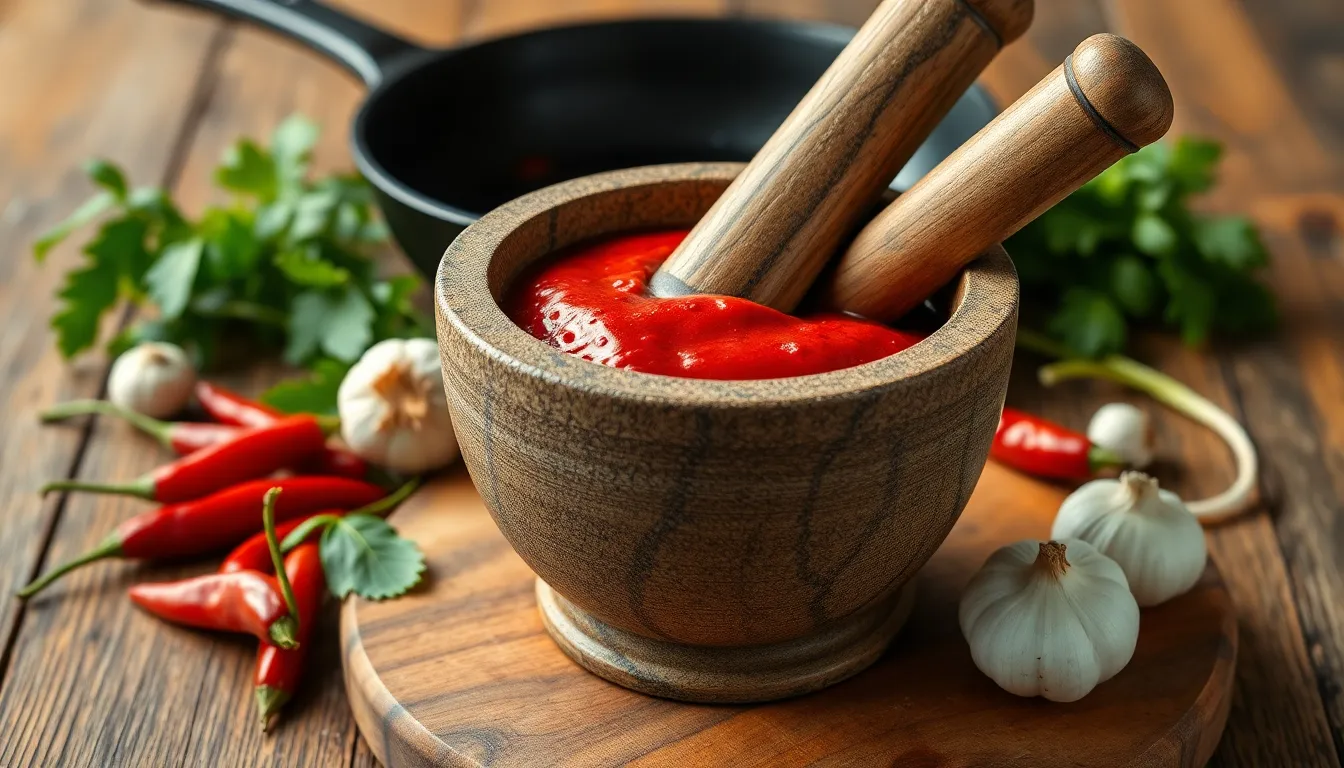
Creating authentic sambal terasi requires just a few essential tools that help develop its characteristic texture and flavor profile. The traditional preparation method relies heavily on these exact pieces of equipment:
- Mortar and pestle (cobek) – The cornerstone of authentic sambal terasi preparation, this stone grinding tool creates the perfect texture by manually crushing ingredients to release their essential oils and flavors. Traditional Indonesian cobeks are typically made from volcanic stone which provides the ideal rough surface for grinding.
- Frying pan or wok – Essential for toasting the terasi shrimp paste until fragrant and for frying ingredients if making the cooked version. A heavy-bottomed pan works best for even heat distribution.
- Sharp knife and cutting board – Necessary for preparing your chilies, shallots, garlic, and tomatoes before grinding. A dedicated cutting board helps prevent cross-contamination of the pungent terasi aroma.
- Small heat-resistant bowl – Useful for holding the toasted terasi and other prepared ingredients before combining them.
- Wooden spoon or spatula – Important for stirring ingredients while frying to prevent burning and ensure even cooking.
- Food processor (optional) – While traditional preparation uses a mortar and pestle, a food processor can serve as a modern alternative for those seeking a quicker preparation method, though many chefs believe it doesn’t develop the same depth of flavor.
- Storage container with tight-fitting lid – For storing any leftover sambal terasi in the refrigerator, allowing the flavors to meld and develop over time.
The beauty of sambal terasi lies partly in its accessibility—you don’t need specialized equipment beyond these basic kitchen tools to create this flavorful condiment that transforms ordinary meals into extraordinary dining experiences.
How to Make Sambal Terasi
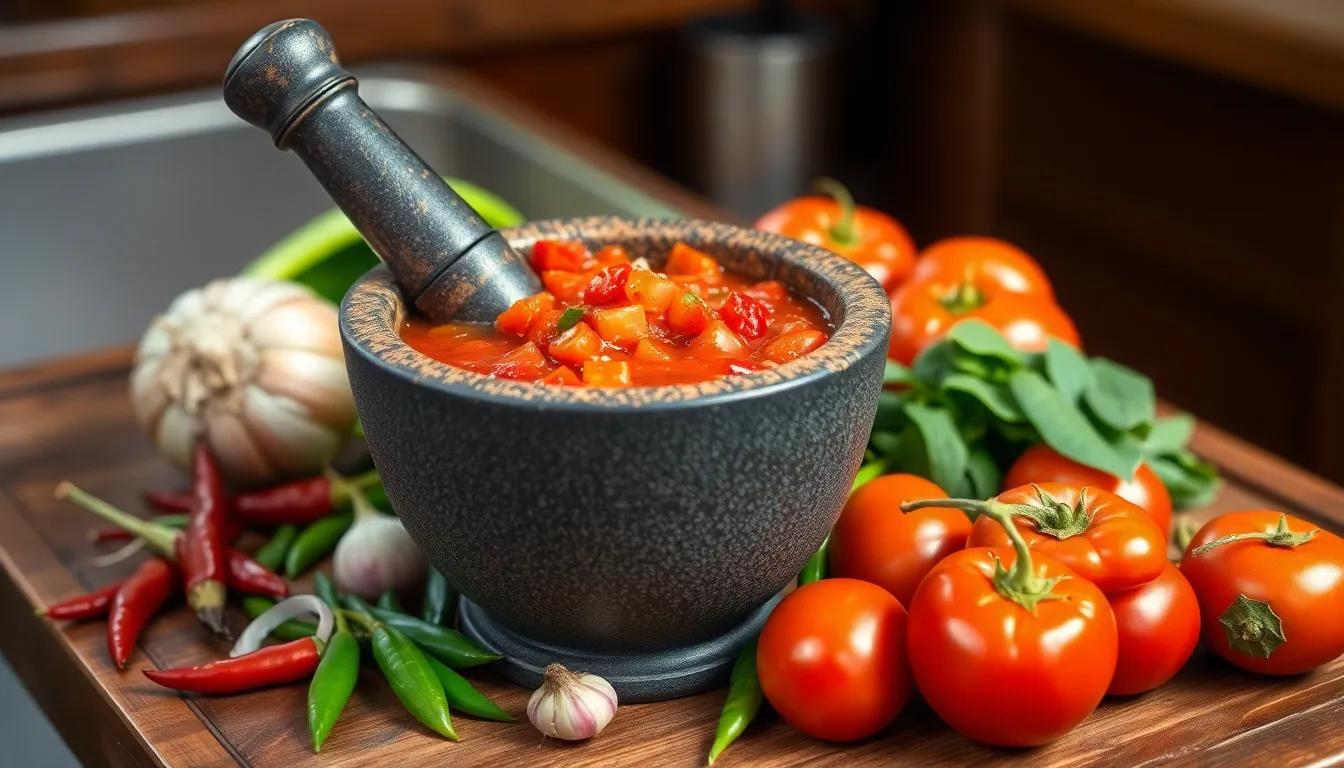
Creating authentic sambal terasi requires attention to detail and traditional techniques that bring out the best flavors in this iconic Indonesian condiment. Follow these step-by-step instructions to prepare this umami-rich chili paste in your own kitchen.
Preparing the Ingredients
Gather these essential components before beginning your sambal terasi:
- 10-15 bird’s eye chilies (adjust according to your heat preference)
- 5-6 larger red chilies for color and fruitiness
- 2-3 tablespoons terasi (fermented shrimp paste)
- 4-5 shallots, peeled and roughly chopped
- 3-4 cloves garlic, peeled
- 2 medium tomatoes, quartered
- 1 tablespoon palm sugar or brown sugar
- 1 teaspoon salt (adjust to taste)
- 1 lime, juiced
- 2 tablespoons vegetable oil for frying
Wash all fresh ingredients thoroughly and remove the stems from chilies. Slice shallots and garlic into smaller pieces to ensure even cooking. Quarter tomatoes to help them break down faster during the cooking process.
Roasting the Terasi
Roasting terasi transforms its pungent raw aroma into a complex fragrant ingredient essential for authentic sambal. You can choose between two effective methods:
Open Flame Method: Hold the terasi with heat-resistant tongs directly over a gas stove flame for 30-45 seconds per side. Turn occasionally until the paste becomes fragrant and slightly charred on the edges. This method quickly develops smoky notes that enhance the final sambal.
Dry Pan Method: Heat a small skillet over medium heat without adding any oil. Place the terasi in the pan and toast for about 5 minutes, turning occasionally until it releases its distinctive aroma. This gentler approach works well if you don’t have access to an open flame.
The terasi is properly roasted when its color darkens slightly and it emits a rich aromatic smell that indicates its flavors have developed fully.
Frying Method
Frying softens the ingredients and marries their flavors together:
- Heat vegetable oil in a pan or wok over medium heat.
- Add the roasted terasi, breaking it apart with a wooden spoon.
- Toss in sliced shallots and garlic, sautéing until translucent and fragrant (about 2 minutes).
- Add chilies and continue cooking for another 3 minutes until they begin to soften.
- Incorporate tomatoes and cook until they break down into a saucy consistency (approximately 5 minutes).
- Season with salt and palm sugar, stirring to distribute evenly.
- Remove from heat and allow the mixture to cool slightly before grinding.
This method creates a more developed flavor profile where the heat from chilies becomes less aggressive while the sweetness from shallots and tomatoes emerges.
Traditional Mortar and Pestle Method
For the most authentic texture and flavor release, use the traditional grinding technique:
- Transfer the fried mixture to a stone mortar (cobek).
- Using a stone pestle (ulek-ulek), begin grinding with a downward pounding motion followed by circular grinding.
- Work the ingredients gradually, starting with the toughest items like chilies.
- Continue grinding until you achieve your desired consistency – traditionally slightly coarse rather than completely smooth.
- Taste and adjust seasoning with additional salt, sugar, or lime juice as needed.
- Allow the sambal to rest for at least 15 minutes before serving to let flavors fully integrate.
While food processors offer convenience, they can’t replicate the texture and oil release achieved with traditional grinding. The mortar and pestle technique extracts essential oils from the ingredients, creating a more harmonious blend where you can still distinguish individual components within the unified paste.
How to Serve Sambal Terasi

Sambal terasi functions as a versatile condiment that elevates the flavor profile of countless dishes. You can serve this pungent chili paste either fresh or cooked depending on your preference and the dish it accompanies.
Traditional Indonesian Pairings
Indonesians traditionally enjoy sambal terasi alongside a variety of authentic dishes that showcase its intense flavor. Fresh vegetables known as lalapan provide a cooling contrast to the paste’s fiery heat. Grilled or fried meats benefit tremendously from this condiment, particularly barbecued fish and chicken where the sambal’s depth complements the smoky flavors. Nasi campur (mixed rice) becomes complete with a dollop of sambal terasi on the side. Many Indonesian curries and soups like laksa receive a important flavor boost from this chili paste, which cuts through rich broths with its heat and complexity. Regional variations exist throughout Indonesia, with some areas preferring more lime for acidity or additional tomato for sweetness depending on the local cuisine.
Modern Serving Suggestions
Beyond traditional applications, sambal terasi has found its way into contemporary global cuisine. You can spread it on sandwiches or tacos for an unexpected flavor explosion that transforms ordinary fare into something extraordinary. A small spoonful mixed into mayonnaise creates a spicy aioli perfect for dipping french fries or drizzling over grilled vegetables. Noodle dishes gain tremendous depth when you stir in a teaspoon of this potent paste. For convenience, store your sambal terasi in sterilized containers in the refrigerator where it keeps well for up to two weeks. Freezing portions in ice cube trays offers an ingenious solution for longer storage, allowing you to pop out just what you need for future meals. Some home cooks shape the paste into “sausage” forms using cling film, which can be sliced while frozen for precise portioning.
Storing Your Homemade Sambal Terasi
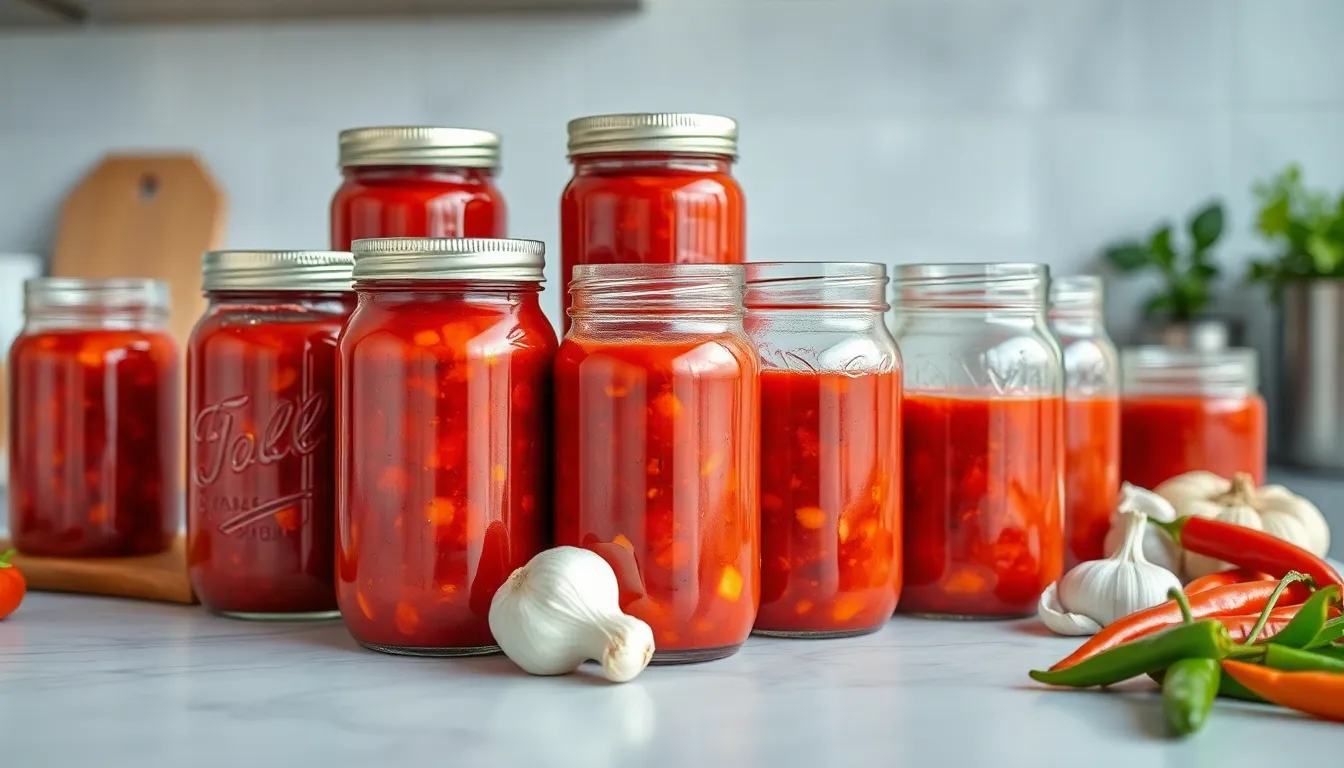
Proper storage extends the life of your sambal terasi while preserving its vibrant flavors and aromatic qualities. After investing time to create this delicious Indonesian condiment you’ll want to ensure it remains fresh and ready to enhance your meals.
Always allow your freshly made sambal terasi to cool completely before storage. Heat trapped in the container can create condensation leading to spoilage or mold growth. Transfer the cooled sambal into thoroughly sterilized glass jars with tight-fitting lids for best results.
When stored properly in the refrigerator unopened sambal terasi maintains its quality for at least one month. Once you’ve broken the seal consume the contents within one week to enjoy optimal flavor and freshness. Sterilized containers extend shelf life up to approximately two weeks in the refrigerator.
For longer preservation consider freezing your sambal terasi in convenient portions:
- Spoon tablespoon-sized amounts onto parchment paper
- Freeze until solid
- Transfer frozen portions to freezer bags or containers
- Label with the date of preparation
This method allows you to thaw only what you need while keeping the remainder preserved. The freezing technique works particularly well for larger batches ensuring nothing goes to waste.
Look for signs of spoilage before using stored sambal terasi. Discard any portion showing mold growth off odors or important color changes. Fresh sambal terasi maintains its vibrant red color though it may darken slightly over time which is normal.
Consider portioning some of your batch into small containers for frequent use while freezing the remainder. This practical approach ensures you always have this flavorful condiment on hand without compromising quality through repeated exposure to air.
Recipe Variations
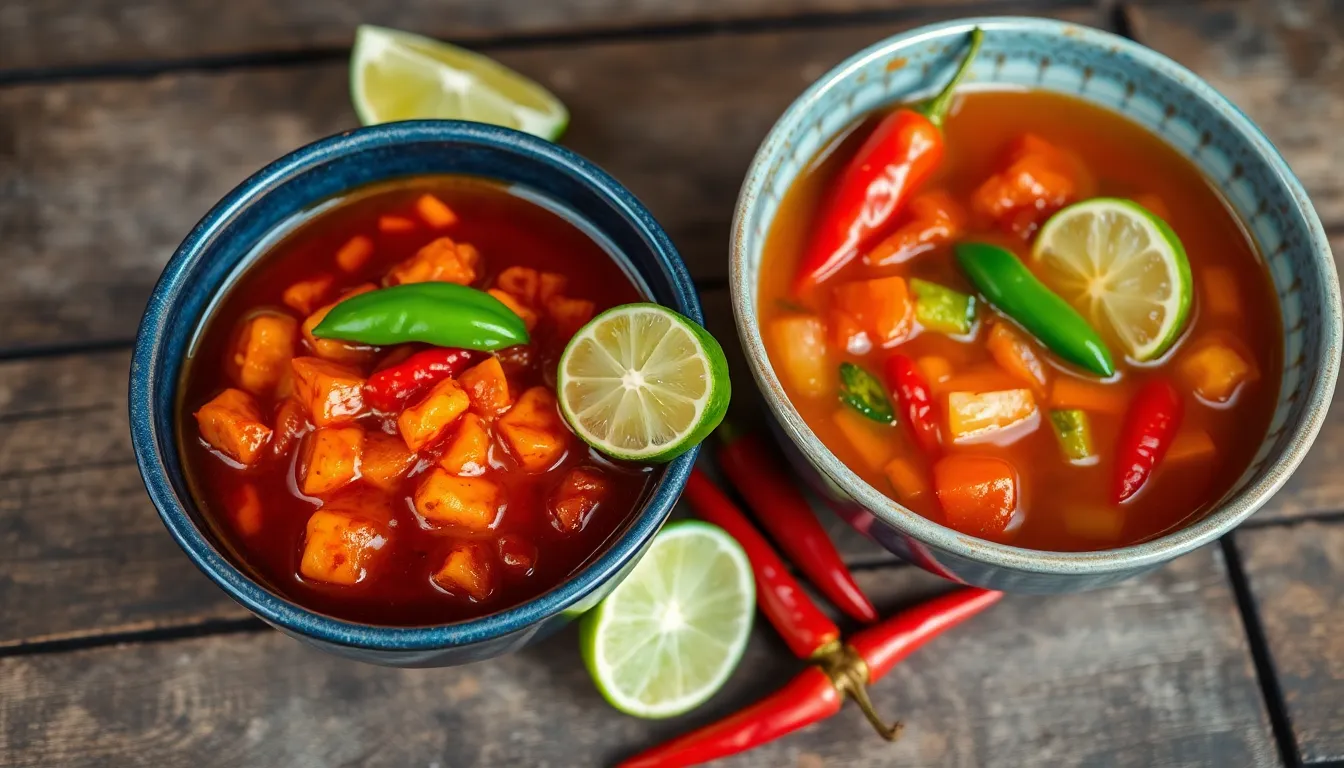
Sambal terasi comes in two distinct traditional preparations that offer different flavor profiles and textures. These variations cater to different taste preferences and can complement various Indonesian dishes.
Sambal Terasi Matang (Cooked Version)
The cooked version of sambal terasi delivers a deeper and more mellow flavor profile through a two-stage cooking process. Begin by frying or stir-frying the dried shrimp paste in oil until it becomes aromatic, which helps tame its intensity while developing richer notes. Next, combine this cooked terasi with garlic, shallots, bird’s eye chilies, red chilies, tomatoes, palm sugar, salt, and lime juice, then grind everything together. For an even more concentrated flavor, fry the ground mixture again to reduce moisture and intensify the taste. This method produces a thicker sambal with stew-like consistency that stores well in the refrigerator for extended periods. The cooking process mellows the sharp edges of the ingredients while creating a harmonious sweet-savory balance that pairs beautifully with rice dishes and grilled meats.
Sambal Terasi Mentah (Raw Version)
Sambal terasi mentah offers a fresher, more vibrant flavor experience that highlights the raw intensity of each ingredient. To prepare this version, simply pound or process fresh chilies, garlic, shallots, tomatoes, lime juice, sugar, and salt together with either raw or lightly toasted shrimp paste. The texture tends to be more watery than the cooked version, with bright, sharp flavors that deliver an immediate punch. This raw preparation creates a lively condiment that particularly shines alongside fried foods or as a fresh accompaniment to vegetable dishes. The tartness and pronounced heat make it perfect for those who appreciate bold, untempered flavors that wake up the palate.
Adjusting the Heat Level
Customize the spiciness of your sambal terasi to suit your personal preference by controlling the type and quantity of chilies. Bird’s eye chilies contribute intense heat, while larger red chilies provide milder spiciness and vibrant color. For a gentler sambal, reduce the amount of bird’s eye chilies or replace them entirely with the milder red varieties. Those seeking maximum fire can increase the bird’s eye chili count or explore even hotter chili varieties. Balance is key in sambal terasi – palm sugar adds sweetness that rounds out the heat, while lime juice contributes acidity that brightens the overall flavor profile. These elements work together to create a perfectly calibrated condiment that enhances rather than overwhelms your dishes.
The Cultural Significance of Sambal Terasi

Sambal terasi represents far more than just a condiment in Indonesian cuisine—it embodies the culinary soul of the nation. This fiery chili paste stands as an emblem of Indonesian food identity with its complex layers of flavor that Indonesians consider essential to complete a meal. Throughout the archipelago sambal terasi accompanies everything from humble street food to sophisticated restaurant dishes creating a consistent thread in the diverse tapestry of regional cuisines.
The cultural importance of sambal terasi extends beyond its flavor profile. Daily meals across Indonesian households feature this condiment prominently alongside rice vegetables and proteins. Indonesian families often develop their own unique recipes passed down through generations with subtle variations that reflect family preferences and regional influences. Many Indonesians believe a meal without sambal terasi feels incomplete regardless of how elaborate the other dishes might be.
Historically sambal terasi connects to the ancient maritime trade routes that shaped Indonesian cuisine. The key ingredient terasi itself has roots in the Cirebon Kingdom of North Java where Prince Walangsungsang recognized the potential of abundant tiny coastal shrimp called rebon. This ingenious preservation method transformed a humble local resource into a prized trade commodity that neighboring kingdoms highly valued. The name “terasi” derives from the Sundanese word “terasih” which translates to love or fondness highlighting the deep appreciation Indonesians have always had for this ingredient.
The preparation of sambal terasi represents Indonesian culinary tradition in its purest form. The rhythmic pounding of ingredients in a stone mortar and pestle creates a distinctly textured paste that machine processing cannot replicate. This labor-intensive process demonstrates the dedication Indonesians have toward food preparation and the belief that proper technique yields superior flavor. The distinctive aroma that fills the kitchen during preparation serves as an immediate signal to everyone in the household that a flavorful meal awaits.
Regional variations of sambal terasi showcase Indonesia’s cultural diversity. Western Java features versions with a higher ratio of fresh tomatoes while Eastern Indonesian preparations often incorporate more lime juice and additional local spices. Each region proudly maintains its distinct interpretation while acknowledging the fundamental importance of the base recipe. These regional adaptations reflect the availability of local ingredients and the historical influences that shaped each area’s culinary traditions.
Sambal terasi also plays a important role in Indonesian social customs. Serving particularly spicy sambal terasi to guests demonstrates hospitality and respect for their palate. Many Indonesians judge the quality of a restaurant primarily by its sambal offering considering it the true test of a chef’s skill. During celebrations and gatherings extra attention goes into preparing exceptional sambal terasi as a way to honor guests and elevate the occasion.
In modern Indonesia sambal terasi continues to evolve while maintaining its cultural significance. Contemporary chefs experiment with innovative presentations and applications without compromising the fundamental character that makes this condiment beloved. The popularity of sambal terasi has spread internationally as global appreciation for Indonesian cuisine grows introducing this distinctive flavor to new audiences while reinforcing its importance as a cultural ambassador.
Conclusion
Sambal terasi stands as a cornerstone of Indonesian cuisine with its perfect balance of fiery heat umami depth and vibrant acidity. This versatile condiment transforms ordinary meals into extraordinary culinary experiences whether used as a dipping sauce mixed into rice or added to stir-fries.
Beyond its impressive flavor profile sambal terasi represents generations of Indonesian culinary tradition with each regional variation telling a unique cultural story. The careful preparation using traditional methods demonstrates the dedication to preserving authentic flavors that have captivated taste buds for centuries.
Whether you choose the cooked matang version or the fresh mentah style you’ll discover why this complex condiment has remained essential on Indonesian tables and is now gaining international recognition. Try making your own sambal terasi and experience how this humble yet powerful condiment can elevate your cooking to new heights.
Frequently Asked Questions
What is sambal terasi?
Sambal terasi is a traditional Indonesian chili paste made from fresh red chilies, fermented shrimp paste (terasi), lime juice, and palm sugar. It’s known for its unique blend of heat, umami, and tanginess that adds depth to various dishes. This iconic condiment serves as both a standalone dipping sauce and a flavor foundation in countless Indonesian recipes.
What makes sambal terasi different from other chili pastes?
The key difference is terasi (fermented shrimp paste), which gives sambal terasi its distinctive umami depth and complex flavor profile. This ingredient creates a savory dimension that’s unmatched by other chili-based condiments. Additionally, the traditional preparation using a stone mortar and pestle creates a coarse texture that retains the individual character of each ingredient.
How is sambal terasi traditionally prepared?
Traditional preparation involves roasting the terasi until fragrant, then grinding fresh red chilies, shallots, garlic, and tomatoes in a stone mortar and pestle (cobek). Some versions are served raw, while others are briefly fried to develop deeper flavors. The grinding process releases essential oils and creates the authentic texture that defines quality sambal terasi.
What dishes pair well with sambal terasi?
Sambal terasi pairs exceptionally well with fried foods, grilled fish, vegetable dishes (lalapan), and rice. It’s commonly served with nasi campur (mixed rice plates), Indonesian curries, and grilled or fried meats. Modern applications include using it in sandwiches, tacos, or mixed with mayonnaise for a spicy aioli. It enhances virtually any savory food.
How long does sambal terasi last?
When stored properly in sterilized glass jars with tight-fitting lids in the refrigerator, sambal terasi can maintain its quality for up to one month. For optimal flavor, consume within one week after opening. You can also freeze it in portioned amounts for longer preservation. Always check for signs of spoilage before using.
Are there different types of sambal terasi?
Yes, there are two main varieties: sambal terasi matang (cooked) and sambal terasi mentah (raw). The cooked version has a deeper, mellower flavor profile and thicker consistency, while the raw version offers a brighter, more intense flavor. Regional variations exist throughout Indonesia, with different areas incorporating local ingredients and spices.
Can I adjust the spiciness of sambal terasi?
Absolutely. You can customize the heat level by adjusting the type and quantity of chilies used. Bird’s eye chilies provide intense heat, while larger red chilies add fruity notes with less spice. Some recipes include seeding the chilies to reduce heat while maintaining flavor. The goal is a balanced profile that enhances dishes without overwhelming them.
What equipment do I need to make sambal terasi?
Traditional preparation requires a stone mortar and pestle (cobek), a frying pan for toasting terasi, a sharp knife and cutting board, and heat-resistant bowls. While a food processor can be used as a modern alternative, traditionalists believe it doesn’t achieve the same depth of flavor as the manual grinding method.
What is the cultural significance of sambal terasi in Indonesia?
Sambal terasi is an emblem of Indonesian food identity and essential to daily meals across the archipelago. It’s often a family recipe passed down through generations, reflecting regional influences and personal preferences. The preparation symbolizes dedication to culinary tradition, and serving spicy sambal to guests signifies hospitality and respect.
Can I find ready-made sambal terasi?
Yes, commercially prepared sambal terasi is available in Asian grocery stores and online specialty food retailers. However, homemade versions offer superior flavor and allow for customization of ingredients and spice levels. The jarred versions serve as convenient alternatives when fresh ingredients or preparation time is limited.
